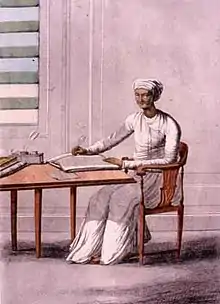Bengali Kayastha
Bengali Kayastha is a Bengali Hindu who is a member of the Kayastha community. The historical caste occupation of Kayasthas throughout India has been that of scribes and administrators;[1] the Kayasthas in Bengal also became "the region's surrogate Kshatriya or warrior class" [2] and, alongside Brahmins, are regarded as the "highest Hindu castes"[3][4][5] that comprise the "upper layer of Hindu society."[6] Swami Vivekananda on status of Kayasthas states:
"I trace my descent to one at whose feet every Brahmin lays flowers when he utters the words — यमाय धर्मराजाय चित्रगुप्ताय वै नमः — and whose descendants are the purest of Kshatriyas. If you believe in your mythology or your Paurânika scriptures, let these so-called reformers know that my caste, apart from other services in the past, ruled half of India for centuries. If my caste is left out of consideration, what will there be left of the present-day civilisation of India? In Bengal alone, my blood has furnished them with their greatest philosopher, the greatest poet, the greatest historian, the greatest archaeologist, the greatest religious preacher; my blood has furnished India with the greatest of her modern scientists."[7]
 A Kayastha of Calcutta, from a 19th century book | |
| Languages | |
|---|---|
| Bengali |
History
Bengali Kayasthas are considered an offshoot of the northern Indian Chitraguptavanshi Kayasths group who claim descent from the sons of Chitragupta. They claim lineage from migrants to Bengal from the ancient city of Kannauj who came at the request of Sena Dynasty kings in the 10th century.[8]
According to Tej Ram Sharma, an Indian historian, the office of Kayastha in Bengal was instituted before the Gupta period (c. 320 to 550 CE), although there is no reference to Kayastha as a caste at that time. He says some scholars have noted that, "originally the professions of Kayastha (scribe) and Vaidya (physician) were not restricted and could be followed by people from different varnas including the brahmanas. So there is every probability that a number of brahmana families were mixed up with members of other varnas in forming the present Kayastha and Vaidya communities of Bengal."[9]
Historians P. C. Choudhuri, K. R. Medhi and K. L. Barua state that "the Brahmins noted in the Nidhanpur and Dubi inscriptions of king Bhaskaravarman" bore surnames "which are at present used by Kayasthas of Bengal and Nagara Brahmins of Gujarat," and "were either of the Alpine origin or pre-Vedic Aryans." Similarly, the Kayasthas and Kalitas of Assam "are also supposed to be descendants of extra-Vedic Aryans".[10]
According to André Wink, another historian, the caste is first referred to around the 5th–6th century CE, and may well have become so identified during the period of the Sena dynasty. Between that time and the 11th–12th century, this category of officials or scribes was composed of "putative" Kshatriyas and, "for the larger majority", Brahmins, who retained their caste identity or became Buddhists. As in South India, Bengal had lacked a clearly defined Kshatriya caste. The Pala, Sena, Chandra, and Varman dynasties and their descendants, who claimed the status of Kshatriya, "almost imperceptibly merged" with the Kayastha caste and became "the region's surrogate Kshatriya or warrior class". [6]
Sekhar Bandyopadhyay also places their emergence as a caste after the Gupta period. Referring to the linkages between class and caste in Bengal, he mentions that the Kayasthas along with the Brahmins and Baidyas, refrained from physical labour but controlled land, and as such represented "the three traditional higher castes of Bengal".[11] Eaton mentions that the Kayasthas continued as the "dominant landholding caste" even after the Muslim conquests on the Indian subcontinent, and absorbed the descendants of the region's old Hindu rulers. [2]
Professor Julius J. Lipner mentions that the caste status of the Bengali Kayasthas is disputed, and says that while some authorities consider that they "do not belong to the twice-born orders, being placed high up among the Shudras; for other authorities they are on a level with Kshatriyas, and are accorded twice-born status."[12]
In Bengal, between 1500 and 1850 CE, the Kayasthas were regarded as one of the highest Hindu castes in the region.[13]
Subcastes
Kulin Kayastha and Maulika Kayastha
According to Ronald Inden, an anthropologist, "many of the higher castes of India have historically been organised into ranked clans or lineages".[13] The Bengali Kayastha was organised into smaller sub-castes and even smaller ranked grades of clans (kulas[14]) around 1500 CE.[15] The four major subcastes were Daksina-radhi, Vangaja, Uttara-radhi and Varendra. The Daksina-radhi and Vangaja subcastes were further divided into Kulina or Kulin ("high clan rank")[13] and Maulika or Maulik, the lower clan rank. The Maulika had four further "ranked grades". The Uttara-radhi and Varendra used the terms "Siddha", "Sadhya", "Kasta" and "Amulaja" to designate the grades in their subcastes.[14]
Origin myths
Kulin Kayasthas have an associated myth of origin stating that five Kayasthas accompanied the Brahmins from Kannauj who had been invited to Bengal by the mythological king Adisur. Multiple versions of this legend exist, all considered by historians to be myth or folklore lacking historical authenticity.[16] According to Swarupa Gupta this legend was
... fitted into a quasi-historical, sociological narrative of Bengal and deployed to explain the realities of caste and sub-caste origins and connections during the late nineteenth and early twentieth century.[17]
According to this legend, the five original Kayastha clans are Bose/Basu, Ghosh, Mitra, Guha, and Datta, the first four of whom became Kulin Kayasthas.[18][19]
Notable people
- Maharaja Pratapaditya, the king of Jessore who declared independence from Mughal rule in the early 17th century, was a Bengali Kayastha.
- Sri Aurobindo, Indian philosopher, yogi and nationalist.[20]
- Nagendranath Basu, historian and editor[21]
- Jagadish Chandra Bose, Indian scientist[22]
- Subhas Chandra Bose, popularly known as Netaji ("Respected Leader")[23]
- A. C. Bhaktivedanta Swami Prabhupada, founder of the Hare Krishna Movement-ISKCON[24]
- Debapratim Purkayastha, Indian educator and bestselling author[25][26]
- Satyendra Prasanna Sinha, 1st Baron Sinha[27]
- Swami Vivekananda (b. Narendranath Datta)[28][29]
- Paramahansa Yogananda, author of ‘Autobiography of a Yogi’.[30]
References
Citations
- Arnold P. Kaminsky, Roger D. Long (2011). India Today: An Encyclopedia of Life in the Republic. ABC-CLIO. p. 404. ISBN 978-0-313-37462-3. Retrieved 4 March 2012.CS1 maint: uses authors parameter (link)
- Eaton (1996), p. 102
- Inden, Ronald B. (1976). Marriage and Rank in Bengali Culture: A History of Caste and Clan in Middle Period Bengal. University of California Press. p. 1. ISBN 978-0-520-02569-1. Retrieved 18 April 2011.
- Verma, Binod Bihari (1973). Maithil Karna Kayasthak Panjik Sarvekshan (A Survey of the Panji of the Karan Kayasthas of Mithila). Uṛīsā : Maithilī Pratibhā. p. 119. ISBN 978-8-190-59110-2. Retrieved 2 June 2017.
- Verma, Binod Bihari (1973). Maithil Karna Kayasthak Panjik Sarvekshan (A Survey of the Panji of the Karan Kayasthas of Mithila). Madhepura : Krānti Bihārī Varmā. p. 148. ISBN 978-8-190-59110-2. Retrieved 2 June 2017.
- Wink (1991), p. 269
- Vivekanada, Swami (1978). The complete works of Swami Vivekananda. Advaita Aashram.
- Hayden J. Bellenoit (17 February 2017). The Formation of the Colonial State in India: Scribes, Paper and Taxes, 1760-1860. Taylor & Francis. p. 34. ISBN 978-1-134-49429-3. Retrieved 10 June 2018.
- Sharma (1978), p. 115
- S. R. Bakshi; S. R. Sharma; S. Gajrani (1998). "Land and the People". Contemporary Political Leadership in India. APH Publishing Corporation. pp. 13–14. ISBN 81-7648-008-8.
- Bandyopadhyay, Sekhar (2004). Caste, Culture, and Hegemony: Social Dominance in Colonial Bengal. Sage Publications. p. 20. ISBN 81-7829-316-1.
- Lipner, Julius J. (2009). Debi Chaudhurani, or The Wife Who Came Home. Oxford University Press. p. 172. ISBN 978-0-19-973824-3.
- Inden (1976), p. 1
- Inden (1976), p. 34
- Inden (1976), p. 1–2
- Sengupta (2001), p. 25
- Gupta (2009), pp. 103–104
- Inden (1976), pp. 55–56
- Hopkins (1989), pp. 35–36
- Aall, Ingrid (1971). Robert Paul Beech; Mary Jane Beech (eds.). Bengal: change and continuity, Issues 16–20. East Lansing: Asian Studies Center, Michigan State University. p. 32. OCLC 258335.
Aurobindo's father, Dr Krishnadhan Ghose, came from a Kayastha family associated with the village of Konnagar in Hooghly District near Calcutta, Dr. Ghose had his medical training in Edinburgh...
- Chakravarty, Ishita (2019-10-01). "Owners, creditors and traders: Women in late colonial Calcutta". The Indian Economic & Social History Review. 56 (4): 427–456. doi:10.1177/0019464619873800. ISSN 0019-4646. S2CID 210540783.
- Gosling (2007). Science and the Indian Tradition: When Einstein Met Tagore.
- A. Pelinka, R. Schell (2003). Democracy Indian Style: Subhas Chandra Bose and the Creation of India's Political Culture. Transaction Publishers. p. 32. ISBN 978-07-6580-186-9.
- "Interview with Srila Prabhupada's Grand-Nephew - Sankarsan Prabhu". bvml.org. Archived from the original on 27 July 2017. Retrieved 11 August 2017.
- Chakravorty, Reshmi (2016-12-13). "Professor Debapratim Purkayastha: The case study expert". Deccan Chronicle. Retrieved 2020-08-21.
- "Dr. Debapratim Purkayastha: Best Selling Case Author". Open The Magazine. 2019-11-08. Retrieved 2020-08-21.
- An Indian In The House: The lives and times of the four trailblazers who first brought India to the British Parliament. Mereo Books. 2019. ISBN 978-1-86151-490-5. Retrieved 4 April 2020.
- Bachchan, Harivansh Rai (1998). In the Afternoon of Time: An Autobiography. India: Penguin Books. ISBN 9780670881581.
- Banhatti, G.S. (1995). Life and Philosophy of Swami Vivekananda. Atlantic Publishers & Distributors. p. 1. ISBN 978-81-7156-291-6. Retrieved 5 July 2012.
- Sananda Lal Ghosh,(1980), Mejda, Self-Realization Fellowship, p.3
Bibliography
- Eaton, Richard Maxwell (1996), The Rise of Islam and the Bengal Frontier, 1204–1760, University of California Press, ISBN 978-0-520-20507-9
- Gupta, Swarupa (2009), Notions of Nationhood in Bengal: Perspectives on Samaj, C. 1867–1905, Brill, ISBN 978-90-04-17614-0
- Hopkins, Thomas J. (1989), "The Social and Religious Background for Transmission of Gaudiya Vaisnavism to the West", in Bromley, David G.; Shinn, Larry D. (eds.), Krishna consciousness in the West, Bucknell University Press, ISBN 978-0-8387-5144-2
- Inden, Ronald B. (1976), Marriage and Rank in Bengali Culture: A History of Caste and Clan in Middle Period Bengal, University of California Press, ISBN 978-0-520-02569-1
- Sengupta, Nitish K. (2001), History of the Bengali-Speaking People, UBS Publishers' Distributors, ISBN 81-7476-355-4
- Sharma, Tej Ram (1978), Personal and Geographical Names in the Gupta Inscriptions, New Delhi: Concept Publishing Company
- Wink, Andre (1991), Al-Hind, the Making of the Indo-Islamic World, Volume 1, Brill Academic Publishers, ISBN 978-90-04-09509-0
